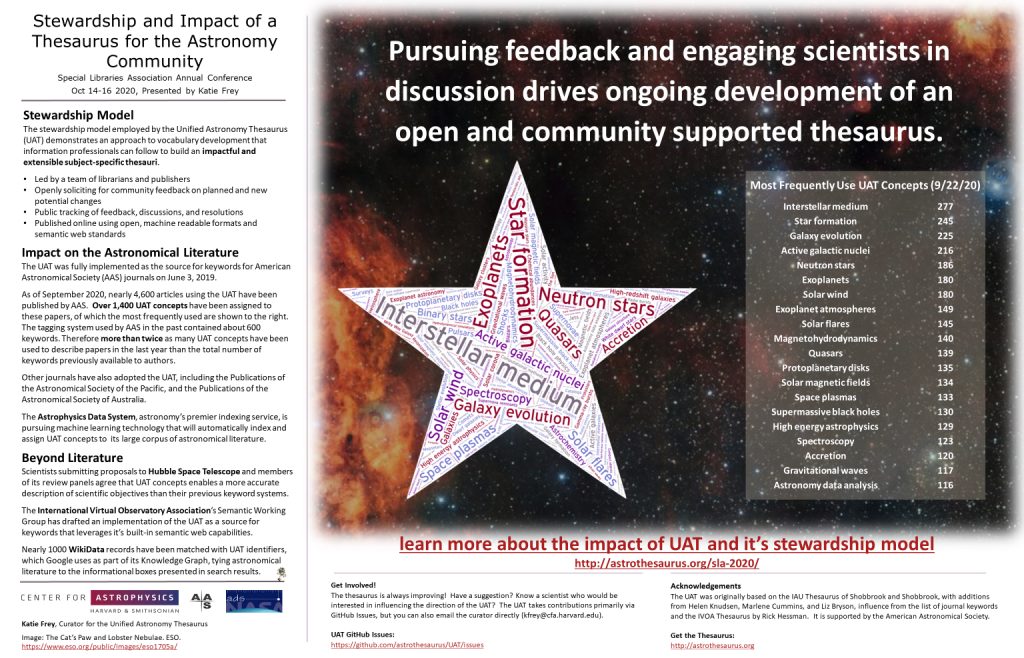Hello and welcome to the Unified Astronomy Thesaurus website! Feel free to explore the concepts of the UAT, and learn more about it’s curation process and the schedule for yearly releases.
UAT Usage Data
Additional Reading
Frey, K. and Bukovi, K. Unified Astronomy Thesaurus: Usage Stats and Release Cycle. Research Notes of the AAS, Volume 4, Number 4 (2020). 2020RNAAS…4…58F
Frey, K. and Accomazzi, A. The Unified Astronomy Thesaurus: Semantic Metadata for Astronomy and Astrophysics. The Astrophysical Journal Supplement Series, Volume 236, Issue 1, article id. 24, 7 pp. (2018). 2018ApJS..236…24F
Frey, K., Weissman, S., Kern, B., Lagerstrom, J., Peek, J., and Accomazzi, A. Managing Contributions to the Unified Astronomy Thesaurus. Library and Information Services in Astronomy VIII: “Astronomy Librarianship in the era of Big Data and Open Science”, Strasbourg, France, Edited by Lesteven, S.; Kern, B.; D’Abrusco, R.; Dorch, B.; EPJ Web of Conferences, Volume 186, 2018. 2018EPJWC.18609003F
SLA Presentation & Poster Information
Stewardship Model
The stewardship model employed by the Unified Astronomy Thesaurus (UAT) demonstrates an approach to vocabulary development that information professionals can follow to build an impactful and extensible subject-specific thesauri.
- Led by a team of librarians and publishers
- Openly soliciting for community feedback on planned and new potential changes
- Public tracking of feedback, discussions, and resolutions
- Published online using open, machine readable formats and semantic web standards
Impact on Astronomical Literature
The UAT was fully implemented as the source for keywords for American Astronomical Society (AAS) journals on June 3, 2019.
As of September 2020, nearly 4,600 articles using the UAT have been published by AAS. Over 1,400 UAT concepts have been assigned to these papers, of which the most frequently used are shown to the right. The tagging system used by AAS in the past contained about 600 keywords. Therefore more than twice as many UAT concepts have been used to describe papers in the last year than the total number of keywords previously available to authors.
Other journals have also adopted the UAT, including the Publications of the Astronomical Society of the Pacific, and the Publications of the Astronomical Society of Australia.
The Astrophysics Data System, astronomy’s premier indexing service, is pursuing machine learning technology that will automatically index and assign UAT concepts to its large corpus of astronomical literature.
Beyond Literature
Scientists submitting proposals to Hubble Space Telescope and members of its review panels agree that UAT concepts enables a more accurate description of scientific objectives than their previous keyword systems.
The International Virtual Observatory Association’s Semantic Working Group has drafted an implementation of the UAT as a source for keywords that leverages it’s built-in semantic web capabilities.
Nearly 1000 WikiData records have been matched with UAT identifiers, which Google uses as part of its Knowledge Graph, tying astronomical literature to the informational boxes presented in search results.
Acknowledgements
The UAT is an open and community supported resource, made possible by the American Astronomical Society.


